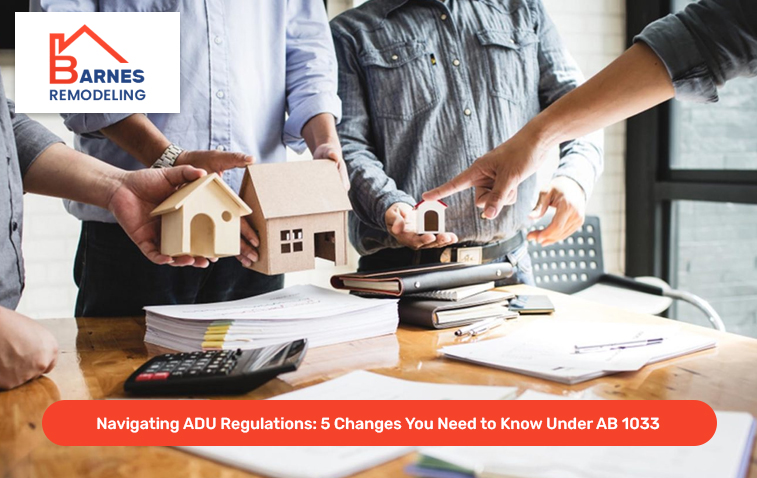Navigating ADU Regulations: 5 Changes You Need to Know Under AB 1033
Accessory Dwelling Units (ADUs) have become a popular way to add extra space to homes these days. Whether expanding a family, increasing rental income, or creating a cozy guest house, ADUs are a convenient solution. However, there are certain legal rules and regulations for ADU construction that need to be kept in mind. Several changes have been made in the state of California under the AB 1033 law, which are designed to make ADU construction easier and govern various aspects of it.
When it comes to adding an ADU to a property, one of the first things to consider is complying with local regulations. Every area may have different rules, but AB 1033 has created several standard rules that must be followed. Several important changes have been made under this law that not only define the size and use of an ADU, but also simplify the process of its construction. It is essential to know about these changes and implement them correctly, so as to avoid any kind of legal complications.
By focusing on the five important changes made to the ADU regulations under AB 1033, you can easily know how to navigate your ADU construction correctly. These changes will help you make the construction process more convenient and your project successful. It is essential to understand each change and plan accordingly so that you can complete your ADU without any legal issues.
More freedom of location for ADUs
Under AB 1033, the rules of location for setting up an ADU have been made more flexible. You can now build ADUs in different parts of your property, giving you more options. This freedom makes ADU construction even more convenient.
Build in any part of the property
As per the earlier regulations, the ADU had to be attached to or adjacent to the main house. However, under the new regulations, you can build an ADU in any part of your property. This also allows you to build in areas that were not being used before, such as the backyard or garden.
Use of side and rear yards
The use of side and rear yards has now become even easier in locating an ADU. By using these spaces, you can build an ADU without cluttering up the space in front or in the middle of your main house. This can make the best use of your yard and give you more building options. By building an ADU in the yard, you can also create a private space for family members.
Amendments to setback requirements
Setback requirements refer to how far the ADU can be built from the property boundaries. Under AB 1033, the setback rules have been changed so that there is more flexibility for ADU construction. This flexibility also applies to areas where property boundaries are tight.
Lesser setback requirement
As per the new rules, building an ADU requires lesser setback than before. This allows building closer to the property boundaries, giving you more space. While a setback of five feet was mandatory earlier, now only four feet may be required in some situations. This makes ADU construction possible even in small yards or tight areas.
Setback exemption in garage conversions
If you want to convert your garage into an ADU, you can get exemption from setback rules. In the case of a garage conversion, you do not need to maintain distance from the property boundaries, making it a convenient option. This change makes garage conversions possible faster and at a lower cost, allowing you to make the best use of the available space.
Limits on the size of ADUs
New rules have also been made on the size of ADUs under AB 1033. This ensures that the ADU is constructed as per the local requirement and property boundaries. The size can also be determined as per the use of the ADU.
Based on percentage of total property area
The size of the ADU can now be determined based on a certain percentage of the total area of the property. For example, if the total area of your property is 4,000 square feet, you can build an ADU of up to 800 square feet. This rule ensures that the property is not overused and the available space is utilized properly.
Maximum and minimum size
As per the new rules, maximum and minimum size limits have also been set for ADUs. The minimum size is determined to ensure that the ADU has adequate space, while the maximum size aims to maintain balance with other parts of the property. This ensures that the ADU looks balanced and harmonious with the main house.
Exemption in off-street parking requirements
Under the earlier rules, off-street parking was required for ADU construction, but under AB 1033, this rule has been relaxed to some extent. This gives more flexibility to those planning to build.
Exemption near public transport
If your property is close to public transport, you will not need off-street parking for the ADU. This rule has been made keeping in mind the accessibility of transport modes, so that the parking requirement is less in areas where public transport is accessible. This exemption makes ADU construction cheaper and easier, especially in urban areas where land availability is less.
Exemption in garage conversions
The requirement of off-street parking has also been eliminated in case of garage conversions. This has made the process of converting a garage into an ADU even simpler. Now you get a chance to convert the garage into a useful space without worrying about additional parking space. This exemption can be very useful for properties that already have parking issues.
Simplification of the ADU approval process
The ADU approval process has also been simplified and made faster under AB 1033. This has made the process more accessible for those planning to build an ADU.
Quick approval
Local authorities are now required to approve ADU construction plans faster. This reduces delays in the process and allows you to start your construction quickly. Where approvals used to take months, the process can now be completed in weeks. This quick process makes ADU construction more attractive, especially for those looking to build quickly.
Pre-approved designs
Some areas now also offer pre-approved designs. This means you can choose from designs that have already been approved by local authorities, saving both time and effort. This makes the design work faster and allows for an early start to construction. This is a great option if you want to save time and avoid legal complications.
These five important changes made to ADU regulations under AB 1033 make ADU construction even simpler and convenient. With the changes made to location, setbacks, size, parking requirements, and the approval process, you can now easily plan and complete ADU construction faster. Keeping these changes in mind, you can successfully complete your ADU project. By following the right planning and regulations at every step, you can build your dream ADU that suits you and your family.
FAQs
Is parking required for an ADU?
If your property is close to public transportation or you are converting a garage into an ADU, parking is not required. This exemption is given in areas where transportation facilities are more accessible. This change is very useful especially in urban areas, where parking may be scarce.
What can be the maximum size for an ADU?
The maximum size of an ADU is decided based on the percentage of the total area of the property. The maximum size may vary depending on the property, but it is intended to ensure balanced construction. This rule ensures that the ADU does not occupy too much of the property and that the property is put to proper use.
Can I convert my garage into an ADU?
Yes, a garage can be converted into an ADU. Under AB 1033, setback and parking rules are exempted for garage conversions, making the process even easier. This option is ideal for properties where there is limited space and more construction is required.
How long does it take to get an ADU approved?
Under AB 1033, local authorities are required to expedite the ADU approval process. The process is now faster and more straightforward than before, allowing you to begin construction quickly. The use of pre-approved designs in some areas makes the process even faster.



